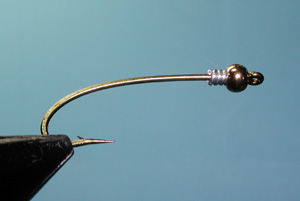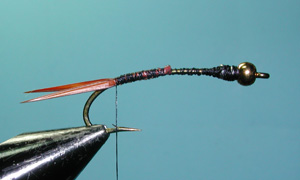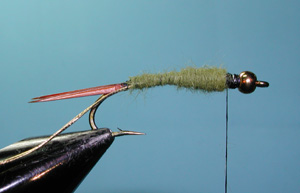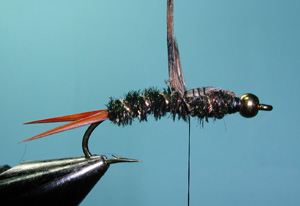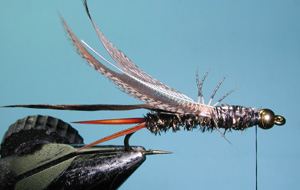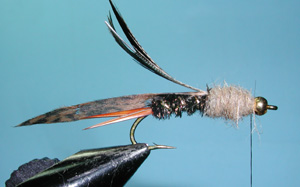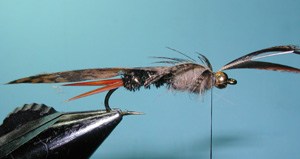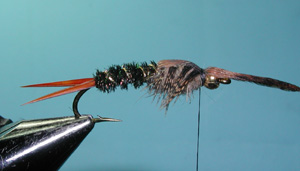Twenty Incher Nymph
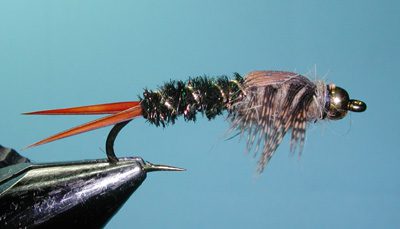
Twenty Incher Nymph
Tying Instructions
| Materials
to Order Material, click the link |
|
|---|---|
| Hook | TMC 200R #8-14 |
| Thread | Danville Black 6/0 |
| Head | Gold Tungsten Bead |
| Underbody | Olive Superfine dubbing |
| Body | Peacock Herl |
| Tail | Brown Goose Biots |
| Thorax | Hare's Ear Plus Dubbing, Hare's Ear |
| Wingcase | Turkey Quill Slip |
| Legs | Partridge |
| Ribbing | Uni-French Small Gold Oval Tinsel |

Twenty Incher Nymph
The Twenty Incher Nymph originated in Colorado by a local tier on the Roaring Fork River. It is a pattern for stonefly nymphs but also is a good attractor nymph. It has been around for at least 20 years, probably earlier when other peacock herl body flies such as the Zug Bug and the Prince Nymph became popular.
Excellent Skwala nymph pattern
It remains an excellent stonefly pattern within the Sierra, particularly the Skwala hatch in sizes 8 and 10. Smaller sizes can be tied to imitate mayfly nymphs. When tying the larger sizes, try using a dubbed underbody with a tapered shape. This will help to get the proper size and shape when using the herl overbody. A TMC 200R gives a nice curved look to the fly. Beadheads are very popular with this pattern in assisting the fly to get to the bottom.
Biots
I am also using Turkey Biots for the tail, you could use Goose biots which are stiffer and more durable. The Turkey biots give this pattern nice movement. The original wingcase was a Turkey Quill segment, however, many today use Pheasant Tail fibers. Some will apply a thick fly finish to the casing for added durability. The ribbing can be Gold or Silver Wire. Some will use oval tinsel or flashabou.
Presentation
Fish this pattern within the rocky bottoms of runs and riffles but where the current is not too strong so that the trout can examine the fly. It is realistic enough to fool a selective trout. In streams or rivers, this pattern can be presented in a number of ways the most successful being a cast up stream like a dry fly and then allowing it to dead drift drag free, keep in contact with your line.
Alternatively, allow the nymph to sink slowly to the bottom just above the vegetation it often seeks and slowly raise the line on the drift, through the water table to attract attention. A slight variation on this is to actually tighten up the line or pull the line as your nymph approaches the lie of a fish you are sight fishing, this will imitate the natural movement of the nymph through the water table.
Variations
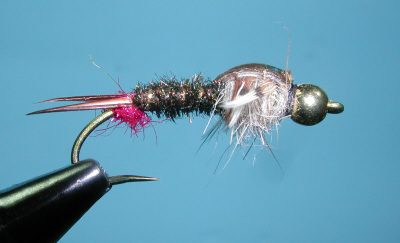
Hot Spot Twenty Incher
| Hook | TMC 200R #8-14 |
| Thread | Danville Black 6/0 |
| Head | Gold Tungsten Bead |
| Underbody | Olive Superfine dubbing |
| Body | Peacock Herl |
| Butt | UV Red Ice dub |
| Tail | Brown Goose Biots |
| Thorax | Hare's Ear Plus Dubbing, Hare's Ear |
| Wingcase | Turkey Quill Slip with Loon Thick fly finish |
| Legs | Partridge |
| Ribbing | Uni-French Small Gold Oval Tinsel |

Double Bead Twenty Incher
| Hook | TMC 200R #8-14 |
| Thread | Danville Black 6/0 |
| Head | Gold Tungsten Bead |
| Body | Peacock Herl |
| Tail | Tan Goose Biots |
| Thorax | Tan Superfine |
| Wingcase | Pheasant Tail with Loon Thick fly finish |
| Legs | Partridge and Black Rubberlegs |
| Ribbing | Uni-French Small Silver Oval Tinsel |

